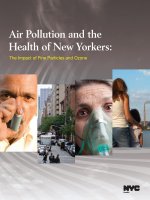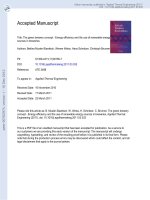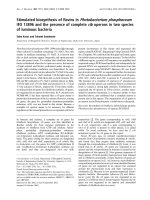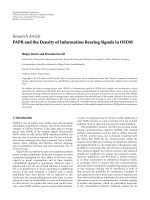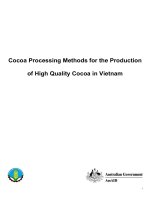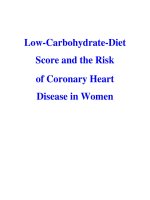Pharmacovigilance and the introduction of new drug regimens in vietnam
Bạn đang xem bản rút gọn của tài liệu. Xem và tải ngay bản đầy đủ của tài liệu tại đây (1.44 MB, 14 trang )
+
Pharmacovigilance and the Introduction
of new drug/regimens in Vietnam
Bangkok, April 2017
Vietnam team
1.
Dr. Hoang Thi Thanh Thuy – Vietnam NTP
2.
Dr. Vu Dinh Hoa – National Center of Drug
Information and Adverse Drug Monitoring
3.
Dr. Nguyen Thi Mai Phuong – Vietnam NTP
4.
Phar. Dinh Thi Thu Huong – Vietnam National Lung
hospital.
Vietnam
Surface 330.000 km2
Border: China, Laos,
Cambodia
Provinces: 63
Districts: 683
Communes: 11,042
Pop.: 93 milion
+ Situation of Drug-resistant
TB in Viet Nam
DRS 3 (06-07)
DRS 4 (11-12)
MDR rate among new TB patients
2.7 % (2.0-3.6%)
4.0 %
(2.5 - 5.4%)
MDR rate among retreated patients
19% (14-25%)
23.3%
(16.7-29.9)
The number of MDR-TB patients among the
number of new TB patients every year
2000 (1500-2700)
3000
The number of MDR-TB patients among the
number of retreated patients every year
1700 (1200-2200)
2100
Total number of MDR-TB patients among total
number of TB patients every year
3700
5100
XDR-TB/MDR-TB
5.6%
FQ res/MDR-TB
16.7%
MDR-TB RESPONSE (PMDT
program)
Progress:
2007: GLC’s approval
2009: pilot in Ho Chi Minh city
Until Dec/2016: Total about 8.500 patients were enrolled,
Treatment success rate: more than 70%
101 pts enrolled in shorter regimen (cohort study)
99 pts enrolled in Bedaquiline individualized regimen (cohort
study)
Current
status:
PMDT coverage: 63/63 provinces
PMDT guidelines: updated with recent recommendations
Training materials available for different target groups.
Xpert MTB/RIF coverage: 100% provinces
SLDs LPA: 2 labs will cover all R+ cases detected in 2017
+ Brief introduction about STR and BDQ
cohort study
Aim: To
assess the new drug containing regimen and
new regimen for
Efficacy (conversion rate, cured rate)
Safety (AEs, lost to follow up, regimen changes)
Sites: 3
cities Hà Nội, TP.HCM, Cần Thơ
Number
of patients recruited: 100/each study
Inclusion
criteria:
BDQ regimen
- Resistance to second line drugs:
injectable or/and FQs
- Intolerance to existing regimen
Shorter regimen
Resistance to R, not to second
line drugs
Strengthening the national PV system to support
PHPs
PV
SYSTEM
National
level
Regional
level
effective linkages
GOAL
Develop a national PV system that
effectively links with and supports
PHP’s practice ensuring drug safety
PHP’s SYSTEM
National
level
Regional
level
Healthcare
facilities
Province &
district level
Patients
Patients
+
PHARMACOVIGILANCE PRACTICE IN VIETNAM
PV system data collection
Spontaneous
reporting
• 9,912 ADR reports (2003 – 2016) ~108.1
reports per million population
• About 10% related to TB drugs
Cohort event
monitoring
• Related to ARV, anti-TB (only MDR and
XDR-TB) drugs and anti-malarial drugs
• At some sentinel sites in PHPs
• Mainly under GF Project
Targeted
spontaneous
reporting
• Up to now, just in HIV/AIIDS programe
(TDF-associated nephrotoxicity, EFVassociated neurotoxicity…)
COLLECTING SAFETY DATA RELATED TO TB DRUGS
Since 1994
Both TB & MDR-TB
Spontaneous
reporting
Since 2014
Cohort
Event Monitoring
MDR-TB at 9 sentinel sites
2014 – 2016; Completed
XDR-TB at 3 sentinel sites
from 2015 to now; On going
CEM in pre-XDR/XDR-TB
Objectives:
o
Describe the characteristics of adverse events of BDQcontaining regimens: severity, type, especially
cardiotoxicity.
o
Analysis of factors affecting the appearance of the AEs of
BDQ-containing regimens.
o
To provide information about drug safety of new TB drug
to support to WHO, NTP and healthcare professionals for
decision making.
Data collection
Form1 Treatment
initiation form
Form 2 Follow up form (AEs,
treatment changed)
Data input,
analysis
Access longitudinal
database
SPSS syntax
+
Reporting form (form 1 and form 2)
Lab. results
AE status
AE
describe
Eg. Creatinine
elevatation
(old/new,
time onset,
persistence)
Severity and
seriousity
Solution for AE
Suspected drug
Full proposal and study tools can be downloaded from
Causality assessment
Adverse event causality assessment
(based on WHO Causality Categories)
Cardiovascular events detected via ECG by cardiologists
For your attention !
